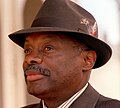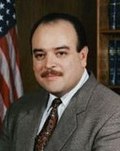| Speaker | Portrait | District | Party | Term of service |
|---|
| 1. Thomas J. White | | Sacramento | Unaffiliated 1 | December 1849–February 1850 |
| 2. John Bigler |  | 12 | Democratic | February 1850–May 1851 |
| 3. Richard P. Hammond | | 7 | Democratic | January 1852–May 1852 |
| 4. Isaac B. Wall |  | 6 | Democratic | January 1853–May 1853 |
| 5. Charles S. Fairfax |  | 15 | Democratic | January 1854–May 1854 |
| 6. William W. Stow |  | 3 | Whig | January 1855–May 1855 |
| 7. James T. Farley |  | 19 | American | January 1856–April 1856 |
| 8. Elwood T. Beatty | | 19 | Democratic | January 1857–April 1857 |
| 9. Ninian E. Whiteside | | 15 | Democratic | January 1858–April 1858 |
| 10. William C. Stratton | | 17 | Democratic | January 1859–April 1859 |
| 11. Phillip Moore | | 16 | Democratic | January 1860–April 1860 |
| 12. Ransom Burnell | | 19 | Douglas Democratic | January 1861–May 1861 |
| 13. George Barstow | | 8 | Republican | January 1862–May 1862 |
| 14. Tim N. Machin | | 12 | National Union | January 1863–April 1863 |
| 15. William H. Sears | | 21 | National Union | December 1863–April 1864 |
| 16. John Yule |  | 20 | National Union | December 1865–April 1866 |
| 17. Caius T. Ryland |  | 7 | Democratic | December 1867–March 1868 |
| 18. George H. Rogers | | 8 | Democratic | December 1869–April 1870 |
| 19. Thomas Bowles Shannon |  | 8 | Republican | December 1871–April 1872 |
| 20. Morris M. Estee |  | 8 | Independent 2 | December 1873–March 1874 |
| 21. Gideon J. Carpenter |  | 23 | Democratic | December 1875–April 1876 |
| 22. Campbell Polson Berry |  | 25 | Democratic | December 1877–April 1878 |
| 23. Jabez F. Cowdery |  | 13 | Republican | January 1880–April 1880 |
| 24. William H. Parks |  | 25 | Republican | January 1881–May 1881 |
| 25. Hugh McElroy LaRue |  | 18 | Democratic | January 1883–May 1884 |
| – William H. Parks |  | 25 | Republican | January 1885–September 1886 |
| 26. William H. Jordan |  | 55 | Republican | January 1887–March 1887 |
| 27. Robert Howe |  | 25 | Democratic | January 1889–March 1889 |
| 28. Frank Leslie Coombs |  | 22 | Republican | January 1891–March 1891 |
| 29. Frank H. Gould |  | 57 | Democratic | January 1893–March 1893 |
| 30. John C. Lynch |  | 8 | Republican | January 1895–March 1895 |
| – Frank Leslie Coombs |  | 18 | Republican | January 1897–March 1897 |
| 31. Howard E. Wright |  | 51 | Republican | January 1899 |
| 32. Alden Anderson |  | 19 | Republican | January 1899–February 1900 |
| 33. Cornelius W. Pendleton |  | 74 | Republican | January 1901–March 1901 |
| 34. Arthur G. Fisk |  | 37 | Republican | January 1903–March 1903 |
| 35. Frank C. Prescott |  | 76 | Republican | January 1905–June 1906 |
| 36. Robert L. Beardslee Sr. |  | 23 | Republican | January 1907–November 1909 |
| 37. Phillip A. Stanton |  | 71 | Republican | January 1909–October 1910 |
| 38. Arthur Hathaway Hewitt |  | 8 | Republican | January 1911–December 1911 |
| 39. C. C. Young |  | 41 | Republican, Progressive 3 | January 1913–April 1917 |
| 40. Henry W. Wright |  | 69 | Republican | January 1919–April 1921 |
| 41. Frank F. Merriam |  | 70 | Republican | January 1923–October 1926 |
| 42. Edgar C. Levey |  | 28 | Republican | January 1927–May 1931 |
| 43. Walter J. Little |  | 60 | Republican | January 1933–July 1933 |
| 44. Forsythe Charles Clowdsley |  | 11 | Democratic | September 1934 (extraordinary session) |
| 45. Edward Craig |  | 75 | Republican | January 1935–May 1936 |
| 46. William Moseley Jones |  | 51 | Democratic | January 1937–March 1938 |
| 47. Paul Peek |  | 71 | Democratic | January 1939–June 1939 |
| 48. Gordon Hickman Garland |  | 38 | Democratic | January 1940–January 1942 |
| 49. Charles W. Lyon |  | 59 | Republican | January 1943–July 1946 |
| 50. Sam L. Collins |  | 75 | Republican | January 1947–August 1952 |
| 51. James W. Silliman |  | 34 | Republican | January 1953–April 1954 |
| 52. Luther H. Lincoln |  | 15 | Republican | January 1955–April 1958 |
| 53. Ralph M. Brown |  | 30 | Democratic | January 1959–September 1961 |
| 54. Jesse M. Unruh |  | 65 | Democratic | September 1961–January 1969 |
| 55. Robert T. Monagan |  | 12 | Republican | January 1969–September 1970 |
| 56. Bob Moretti |  | 42 | Democratic | January 1971–June 1974 |
| 57. Leo T. McCarthy |  | 19/18 4 | Democratic | June 1974–November 1980 |
| 58. Willie Brown |  | 17/13 5 | Democratic | December 2, 1980 – June 5, 1995 |
| 59. Doris Allen | | 67 | Republican 6 | June 5, 1995 – September 14, 1995 |
| 60. Brian Setencich | | 30 | Republican 6 | September 14, 1995 – January 4, 1996 |
| 61. Curt Pringle |  | 68 | Republican | January 4, 1996 – November 30, 1996 |
| 62. Cruz M. Bustamante |  | 31 | Democratic | December 2, 1996 – February 26, 1998 |
| 63. Antonio Villaraigosa |  | 45 | Democratic | February 26, 1998 – April 13, 2000 |
| 64. Robert M. Hertzberg |  | 40 | Democratic | April 13, 2000 – February 6, 2002 |
| 65. Herb J. Wesson, Jr. |  | 47 | Democratic | February 6, 2002 – February 9, 2004 |
| 66. Fabian Núñez |  | 46 | Democratic | February 9, 2004 – May 13, 2008 |
| 67. Karen Bass |  | 47 | Democratic | May 13, 2008 – March 1, 2010 |
| 68. John Pérez |  | 46/53 7 | Democratic | March 1, 2010 – May 12, 2014 |
| 69. Toni Atkins |  | 78 | Democratic | May 12, 2014 – March 7, 2016 |
| 70. Anthony Rendon |  | 63 | Democratic | March 7, 2016 – June 30, 2023 |
| 71. Robert Rivas |  | 29 | Democratic | June 30, 2023 – present |




























































